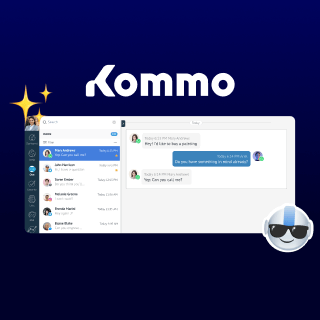WhatsApp message templates are pre-approved by Meta. Businesses use them to start a new chat with a client or continue an existing conversation. These templates are the only way companies can reach out first, whether to send reminders, updates, or special offers.
WhatsApp Business templates in Kommo
When creating a new WhatsApp template in Kommo, you’ll need to fill out several fields. Here’s what each one means and how to use it:
Category
Choose the purpose of your template:
-
Marketing – for promotions, offers, and engagement messages.
-
Utility – for reminders, updates, and transactional messages.
-
Authentication - coming soon to Kommo.
Message type
Available options depend on the category you select:
-
Marketing: Custom, Carousels, Flows
-
Utility: Custom, Flows
Note: Carousels are only available for Marketing. Flows require a verified WhatsApp Business Account (WABA). Learn more about Flows templates in our article.
Title
A name for your template (only visible inside Kommo).
WABA ID
Select the WhatsApp Business Account you’d like to link this template to.
Language
Choose the language of your message. The language selected must match your text exactly, otherwise Meta will reject the template.
Header
Optional. Add text, an image, or a video to appear at the top of your message.
Body
The main content of your message. This is where most of your text goes.
Footer
Optional. Add a short closing note at the bottom of the message.
Buttons
Add call-to-action buttons to encourage quick replies or actions:
-
Quick reply button: up to 3 buttons
-
URL button: up to 2 buttons
Personalizing with placeholders
On the right side of the New WhatsApp template window, you’ll see placeholders. These are variables written in square brackets (e.g., [Lead name]). Placeholders automatically pull data from a lead, contact, or company card to personalize each message.
If you select placeholders like [Lead name] and [Lead responsible user], your template will look like this: “Hey [Lead name]! 👋 You have an appointment with [Lead responsible user] at 6PM. 🗓️ Looking forward to seeing you! ✨”.
Kommo will then ask you to add an example for each placeholder. This field appears at the bottom of the form and helps you see how the final message will look. In this case, the final message would look like: “Hey Sarah! 👋 You have an appointment with David at 6PM. 🗓️ Looking forward to seeing you! ✨”.
Tip: Meta will reject templates that contain only placeholders with no additional text. This prevents businesses from sending blank or spammy messages. Always include meaningful text along with your placeholders.
Create and submit WhatsApp message templates for approval
To create and send a template for Meta’s approval in Kommo:
-
Go to WhatsApp (on your left menu) > Templates > WhatsApp templates and click Add a new template.
-
Select a category: Marketing or Utility.
In each tab, you will see the available message types:
-
Marketing: Custom, Carousel, or Flows
-
Utility: Custom or Flows
Choose the type of message you want to use and click Next.
Then, fill in the template fields.
-
Click Save draft anytime to avoid losing progress. You can reopen it later to continue editing.
When your template is ready, click Send for approval to submit the template for Meta’s review. The review process typically takes between 1 minute to 48 hours.
Message templates statuses
After you submit a WhatsApp template, Meta reviews it. In Kommo, you can track the status of each template. Here’s what each status means:
-
Draft – Saved but not submitted for review.
-
In review – Waiting for Meta’s approval.
-
Approved – The template is ready to use.
-
Paused – Temporarily blocked due to low quality or policy violations. It will be paused for 3 or 6 hours to protect the phone number rating.
-
Rejected – Meta did not approve the template. Hover over the rejected status to see the reason.
You can then edit the template and resend it for approval by repeating the process or choose to delete it by clicking on Delete template.
Common reasons for template rejection
If your WhatsApp template is rejected, it’s usually due to one of the following:
-
Missing variable parameters example: Make sure to provide an example for each placeholder in a template.
-
Variable parameters contain special characters: Placeholders can’t contain characters like #, $, or %.
-
Message templates violate WhatsApp's Commerce Policy: When offering products or services for sale, all related messages and multimedia content must comply with WhatsApp's Commerce Policy, including prices, descriptions, fees, taxes, and legal disclosures.
-
Message templates violate WhatsApp's Business Policy: Avoid requesting confidential identifiers from users, such as complete payment card numbers, bank account numbers, or personal identification numbers. Partial identifiers (e.g., The last 4 digits of a social security number) may be requested. Refrain from requesting documents that may contain confidential identifiers.
-
Content includes potentially abusive or threatening material: Templates cannot contain threats of legal action or public shaming.
-
Duplicate templates: Avoid sending templates with identical text in the body and footer as an existing template.
If you need more help with setup or troubleshooting, feel free to reach out to our support chat or contact us via WhatsApp. You can also hire a Kommo partner to do all the hard work for you.
Not a user yet? Sign up for our 14-day free trial or book a live demo.











